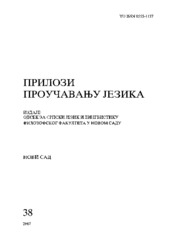Приказ основних података о документу
Предлошки генитив са семантичким обележјем аблативности у именичком изразу у језику романа Преображење Војислава Лубарде
The Prepositional Genitive with the Semantic Ablative Marker in Noun Phrases in the language of the Novel Preobraženje by Vojislav Lubarda
| dc.creator | Симић, Зоран | |
| dc.date.accessioned | 2020-12-01T15:34:40Z | |
| dc.date.available | 2020-12-01T15:34:40Z | |
| dc.date.issued | 2007 | |
| dc.identifier.issn | 0555-1137 | |
| dc.identifier.uri | https://dais.sanu.ac.rs/123456789/9737 | |
| dc.description.abstract | У раду се разматрају именички изрази из језика романа Преображење Војислава Лубарде, односно предлошке генитивне конструкције са семантичким обележјем аблативности које представљају зависни члан забележених именичких израза а примарно су адвербијалног карактера. Након класификовања ових конструкција, према основним видовима манифестовања семантичког поља аблативности — удаљавање и потицање, трансформационом анализом утврђује се њихова синтаксичко-семантичка позиција, односно њихово значење у првом семантичком плану, као и однос употребе различитих аблативних предлога у конкретној реализованој позицији. | sr |
| dc.description.abstract | The paper examines nominal phrases from the novel Preobrazenje by Vojislav Lubarda. It deals with prepositional genitive structures with the semantic ablative marker which appear as dependend parts of nominal phrases and are primarily of nominal type. The analysis has shown that the ablative type of origin or source, where the source is predominantly defined as the place of origin, is the major ablative form by means of which the genitive structure defines the head noun. The form of prepositional genitive js mainly found in geographical items which primarily take the preposition JZ (FROM). The analysis has also revealed that the particular ablative preposition which appears with the genitive form of noun chiefly depends on the inherent lexical semantics of the noun which is the dependent part of a noun phrase i.e. on the conceptualization of the notion expressed by the genitive form of the noun. The transformative analysis of the prepositional genitive structures with the semantic ablative marker has shown that in the deep structure they may have various syntactic and semantic positions: semantic subjects (doers of the action), object-ablatives, noun complements, and, in most cases, adverbial determiners, spacial and temporal. | en |
| dc.language.iso | sr | sr |
| dc.publisher | Нови Сад : Филозофски факултет | sr |
| dc.rights | openAccess | sr |
| dc.rights.uri | https://creativecommons.org/licenses/by-nc-nd/4.0/ | |
| dc.source | Прилози проучавању језика | sr |
| dc.subject | српски језик | sr |
| dc.subject | синтакса и семантика падежа | sr |
| dc.subject | аблативност | sr |
| dc.subject | генитив | sr |
| dc.subject | предлози ОД | sr |
| dc.subject | ИЗ | sr |
| dc.subject | С(А) | sr |
| dc.subject | Војислав Лубарда | sr |
| dc.subject | Преображење | sr |
| dc.title | Предлошки генитив са семантичким обележјем аблативности у именичком изразу у језику романа Преображење Војислава Лубарде | sr |
| dc.title | The Prepositional Genitive with the Semantic Ablative Marker in Noun Phrases in the language of the Novel Preobraženje by Vojislav Lubarda | en |
| dc.type | article | sr |
| dc.rights.license | BY-NC-ND | sr |
| dcterms.abstract | Simić, Zoran; Predloški genitiv sa semantičkim obeležjem ablativnosti u imeničkom izrazu u jeziku romana Preobraženje Vojislava Lubarde; | |
| dc.citation.spage | 107 | |
| dc.citation.epage | 129 | |
| dc.citation.volume | 38 | |
| dc.type.version | publishedVersion | sr |
| dc.identifier.fulltext | https://dais.sanu.ac.rs/bitstream/id/40425/simic.lubarda.2007.pdf | |
| dc.identifier.rcub | https://hdl.handle.net/21.15107/rcub_dais_9737 |

